|
|
|
This page explains some of the paw anomalies that can occur in cats, other than extra toes.
SYNDACTYLY (OLIGODACTYLY) & ECTRODACTYLY
|
|
|
Syndactyly (hypodactyly) or split-foot is the opposite of polydactyly. Instead of having additional toes, the cat's forefeet (rarely the hind feet) have one or more toes fused. In the most familiar form, called Ectrodactyly, there is a central split and two toes giving the appearance of a crab or lobster claw. In humans, the condition is sometimes known as "lobster-hand". The other digits have either been suppressed altogether or each of the cat's toes is made up of two or more fused digits. A paper by A G Searle (in "Annals of Eugenics" Vol. 17, Part 4, pp. 279-283, 1953) discussed the lobster-claw condition in cats; Searle noted that the anomaly was usually inherited as a dominant, and had suggested that the right side was often more severely affected than the left.
Syndactyly and Ectrodactyly are visually similar. Ectrodactyly is the "lobster claw" defect where the paw is split longitudinally, most commonly between the first and second toes. In different mammals there are both dominant and recessive forms of this defect. It often occurs on one side only and there may be other abnormalities: deformed or under-developed toes and partly fused toes. Syndactyly involves the union of bony and/or soft tissue of two or more toes and can be hereditary or congenital (non inherited). Hereditary syndactyly usually occurs on both sides while congenital syndactyly often affects only one side. As the conditions are similar and rarely distinguished from each other in cats, I have used the term syndactyly from hereon.
Syndactyly is rarer than polydactyly so I was interested to receive details of a cat with 4 affected paws. Each paw resembles a crab's pincer (hence the common name of "Lobster Claw Syndrome"), having only 2 toes which are semi-opposable. The cat even uses them as pincers to hold toys and small objects. The toes are apparently oriented one facing upwards and one facing downwards (i.e. a degree of twisting). Syndactyly varies from webbed toes to fused digits. The fused digits can be simple with the digits connected only by skin, or it can be complicated with the bones, tissues and claws fused. It occurs when the cells between each toe do not die during embryo development and the toes do not separate (these cells are normally programmed to die during digit formation).
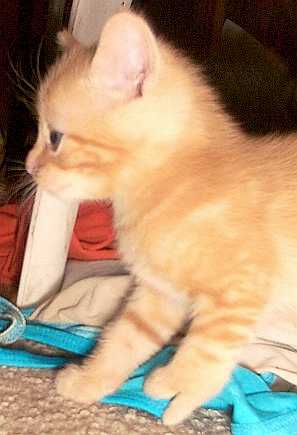
Like polydactyly, the condition rarely causes problems so long as the claws are kept clipped. The cat can still run and climb. The only time I have seen a lobster-clawed cat was with a feral cat in a trap-neuter-release program. This may not have caused problems to the cat in the wild (on a farm), but it caused problems in temporary captivity as the claws kept getting caught on the wire mesh. The actual claws were slightly overgrown due to problems with stropping them. In pet cats this can easily be rectified by frequent claw clipping.
Where the two toes are made of fused digits, the claws may form superclaws in the same way as described earlier. There is also the possibility that the cleft between the toes extends further than is normal into the paw itself. Small objects, thorns etc may become trapped between the toes. If the toes splay apart e.g. when the cat has jumped down from a high platform, there is the small chance that the claws will spread apart under its weight and the skin between them may tear. These problems are not common and cats with split foot rarely suffer any real disability.
In May 2005, Stephanie Rubeck of Newark, Ohio, sent this picture of her 4 week old kitten "Faith" who has syndactyly of the left front paw. The vet refused to see the kitten until she reached 6 weeks old on the grounds that a defective kitten would be rejected by the mother and not survive that long. Syndactyly is a minor (cosmetic) defect that does not affect suckling or threaten long-term survival. Faith is one of a litter of two and her brother is solid black with no abnormalities. At 4 weeks, Faith had a few problems walking, mainly when trying to turn around or turn to the left, but should soon learn to compensate. Her climbing abilities are not impaired and the photo shows Faith playing on the couch with her brother.
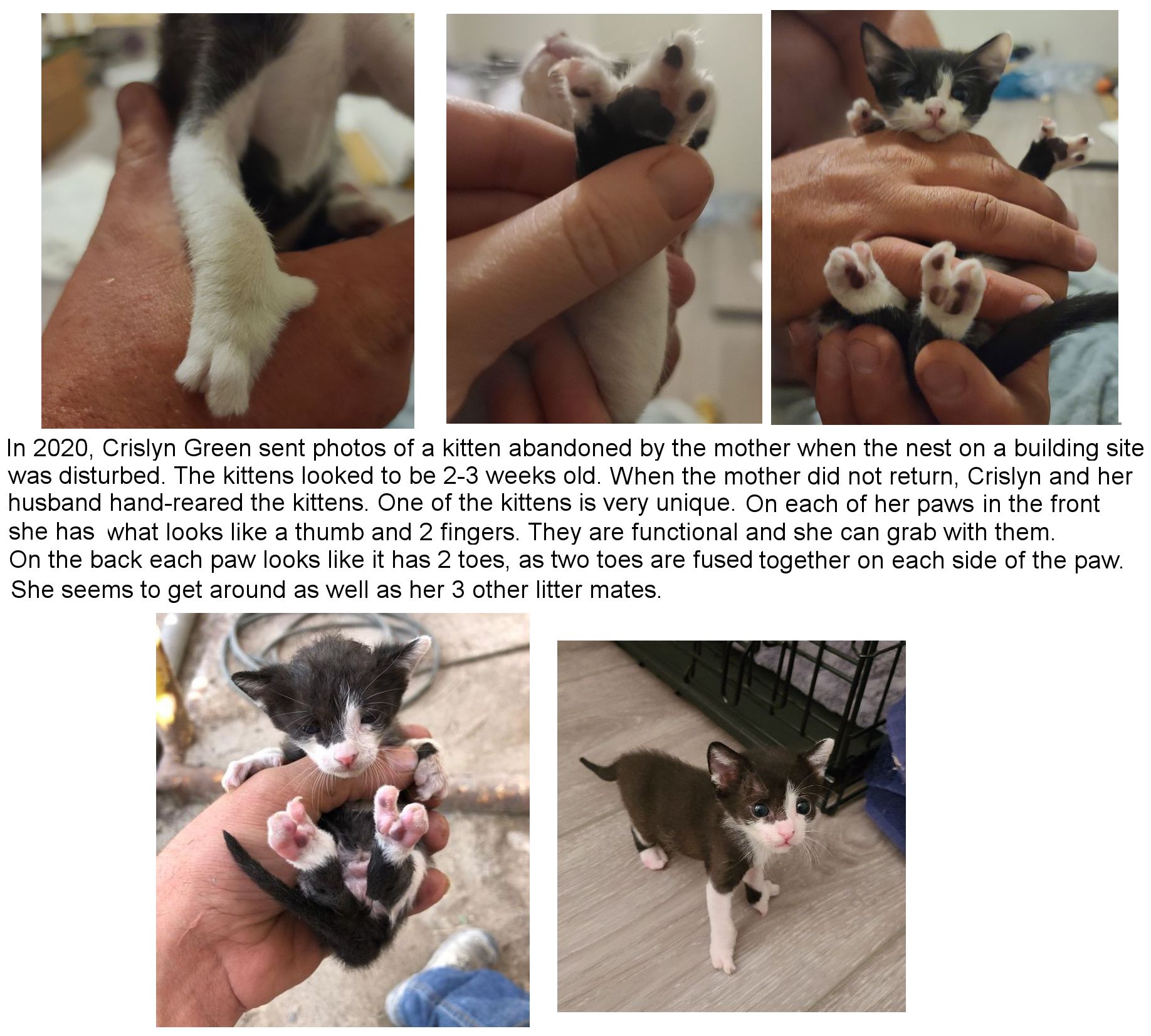
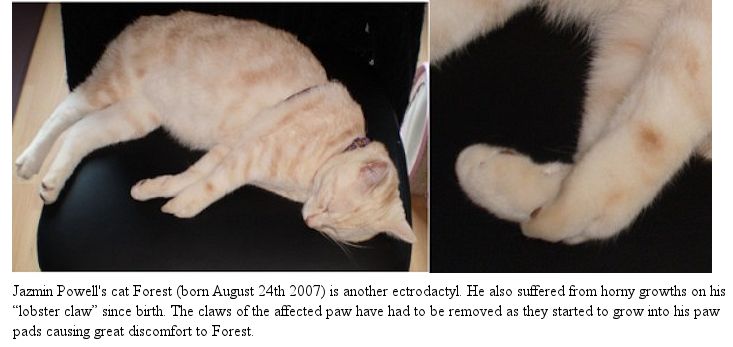
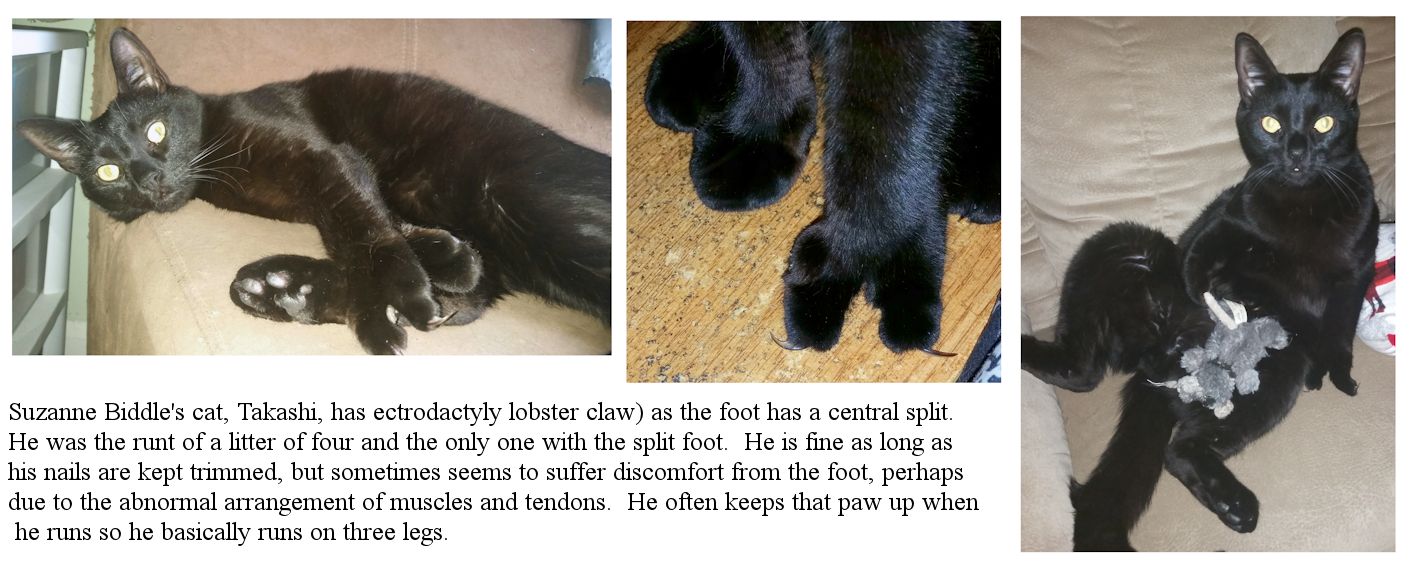
|
|
Zack, belonging to Carrie, is a neutered 5 year old male with syndactyly of both front paws. He has two toes on one front paw (including a superclaw) and three toes on the other, not counting the dew claws. Zack cannot retract any of his front claws. In addition, his front feet are very short compared to his hind feet and the toes lack some finger joints. When standing, he looks as if he's on the very tips of his front toes. Short toes is known as brachydactyly. Zack has few if any mobility issues. He can walk, run, jump, scratch, and knead normally. He's never shown much aptitude for climbing - or much inclination to climb (and therefore has the freedom of an enclosed yard). Carrie trims Zack's claws on a weekly basis. He doesn't use his front claws for fighting or scratching in self-defence, preferring to grab-and-bite instead and to bat with his paws when play-fighting. He also uses use his front paws to manipulate toys, open cabinets, etc and is not inconvenienced by the length or number toes.
|
|
These photos and x-rays have been sent by Carla Reiss whose cat Bimmer has a deformed foot. The x-rays were provided by The Center for Advanced Veterinary Care in Manchester, NH, USA. Each side of the deformed foot has two digits, plus additional claws here and there. The wrist is not properly formed, with the tibia and fibula being uneven lengths. The digits, some associated with the tibia and some with the fibula, criss-cross. Carla’s vet, Deborah Kelloway, said she had never seen as gross a deformity of a cat’s foot. It is rather like a lobster claw and he can grasp with it. He walks and runs with the leg held out in front of him. Some of the claws look normal, while others look more like fleshy growths pointing in all directions. He really isn't impeded by his leg and he lives a grand life with Carla, Steve and six other cats. Bimmer is said to be a sweet boy and inseparable from another cat, Audi.
A. G. SEARLE described the “lobster foot “ condition in his paper “Hereditary ‘Split-Hand’ in the Domestic Cat” (Annals of Eugenics, Vol. 17, Part 4, 1953). [Note: “Eugenics” was used in the positive sense of understanding human genetics through a statistical understanding of heredity, not in the negative sense of ethnic cleansing. Yesterday’s “eugenics” is today’s “genetic screening.”] He writes “A skeletal deformity of the fore-limbs has been discovered in the domestic cat, appearing to be homologous with the type of ectrodactyly in man known as ‘split-hand and split-foot’ or ‘lobster-claw . . . Structurally the various anomalies found in the cat can be paralleled fairly exactly in human material. The cross-bones found so far are not, perhaps, quite typical; at one end this bone fuses with the adjacent proximal phalanx instead of articulating with it and its associated metacarpal, as is usual.”
“A yellow blotched tabby female, was discovered to have abnormal fore-paws when in an animal house awaiting use in physiological research. She was removed from there forthwith and allowed to breed freely. X-rays of her fore-limbs (Pl. 1) show a central cleft in each manus, with reduction of the central ray. In the left manus a cross-bone leads from metacarpal III into the proximal phalanx of the defective second digit. In the right, the proximal phalanx of the third digit is atrophic distally; and the other two phalanges are absent. In both there is syndactyly between the fourth and fifth digits. There is a clear resemblance between these skeletal anomalies and those typically found in human split-hand. The cat's hind-limbs appear normal from the outside and X-rays confirm that the bones are quite unaffected.
Since being kept under observation this cat has produced five litters, within a space of 16 months. She did not look fully grown when first obtained, so it is unlikely that she has bred previously. Of her twenty-six kittens, none of which were stillborn, seven have had abnormal paws. The proportion of abnormals in successive litters has been 0/5, 2/6, 2/7, 3/4, 0/4. At least thee different, males were involved; although it was not possible to examine the fathers closely it can he assumed with confidence that they were normal for the character in question. The probability of obtaining a 7 : 19 ratio with an expectation of 1 : 1 is 0.0098, significant at the 1% level. So split-hand seems to be due to the action of a gene in heterozygous condition, which does not always manifest itself. It clearly has no adverse effect on fertility. The existence of normal overlaps is also suggested by the wide variation in expression of the character. with some abnormal offspring only slightly affected. In none did the hind-limbs show any signs of deformity. Two abnormals were killed at birth; both were unaffected on the left but had highly abnormal right fore-paws, with deep clefts, absence of digits and syndactyly. Of the five others, one is again unaffected on the left (Pl. 2c), while on the right the distal phalanges of the central ray are missing and those of ray II are defective. In two (Pls. 2.a, b) there is an approach to bilateral symmetry, with syndactyly and only a slight cleft in one, while the other has cross-bones from the third to the second ray.
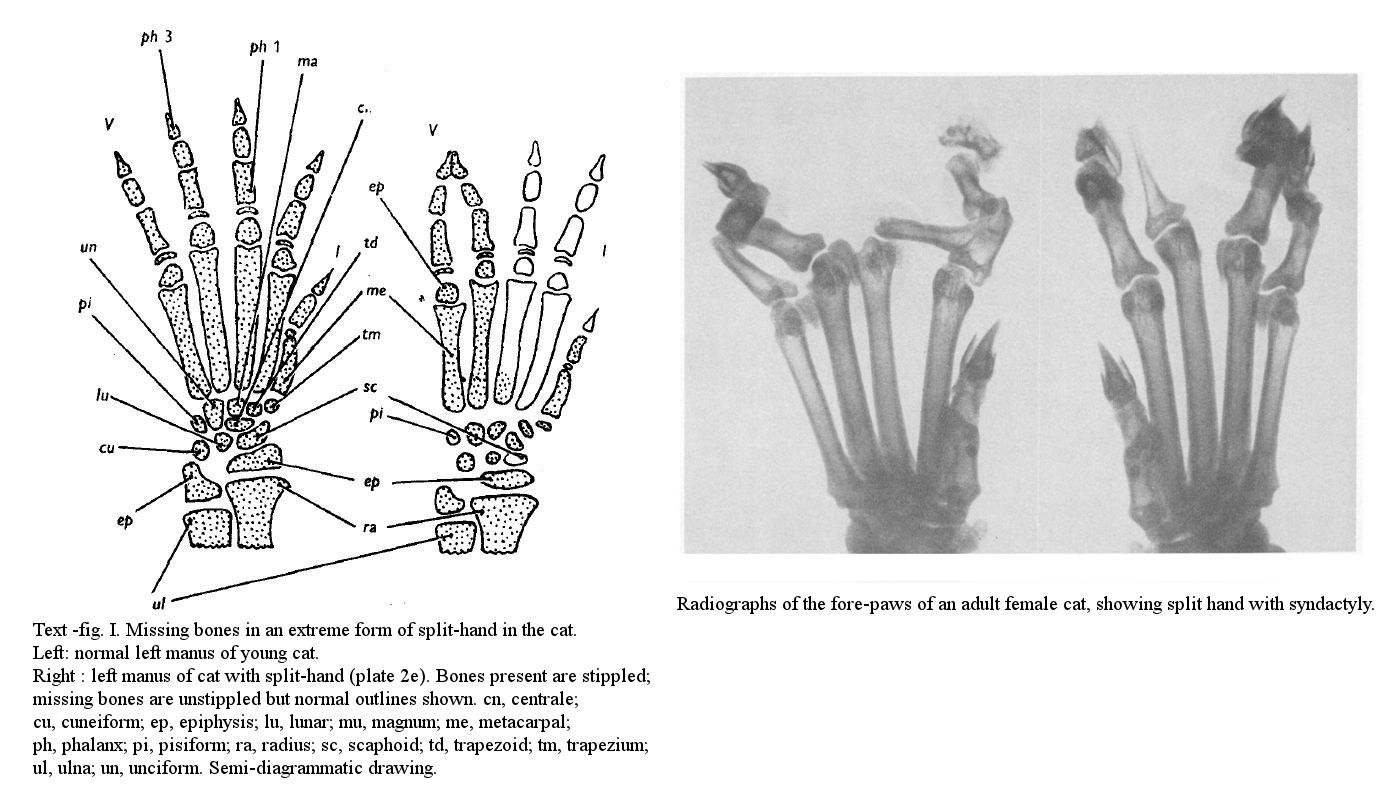
A more severe condition, with effects on the radial rays, is seen in the other two abnormals (Pls. 2d, e ) . In the former, the whole of the third ray is absent on both sides, with syndactyly of the fourth and fifth digits. On the right, ray II also seems to be absent; on the left it is disorganized and ray I is very much reduced, only the atrophic base of the metacarpal remaining. The fore-paws shown in Pl. 2e lack both the second and third rays, except for a vestige of the third metacarpal; the pollex is also reduced with loss of its distal phalanx. For the first time the carpus is also affected, with an apparent loss of the scaphoid (which normally fuses with lunar and centrale in the adult cat to form the scapho-lunar bone) and the pisiform. Text-fig. 1 gives a clearer picture of the situation in this animal. Where syndactyly occurs a double claw may be formed, just as a double nail may be found in man. Fusion of adjacent paw-pads, normally found under each digit except the first, may also occur. Pl.3 shows the external appearance of the fore-paws of the two most severely affected kittens. Neither seems much handicapped by its deformity. Their gait appears normal; they are able to run and jump, but their deficiency in claws makes climbing difficult.”
In the belief that there ought to be a standard set of gene symbols for cat as well as mouse mutants, Searle proposed the symbol Sh for the split-hand gene responsible and concluded that the deformity found in the domestic cat appeared to be homologous with the human ‘split-hand and split-foot ’ anomaly. The condition appeared to be due to a heterozygous gene with somewhat irregular manifestation. He also thanked Miss Ann Walker tor bringing the original ‘lobster-claw ’ cat to his attention and finding her a good home, and to Mr and Mrs Richard Wilmot for looking after her. The cat’s mutation meant she had a lucky escape from becoming a laboratory research animal.
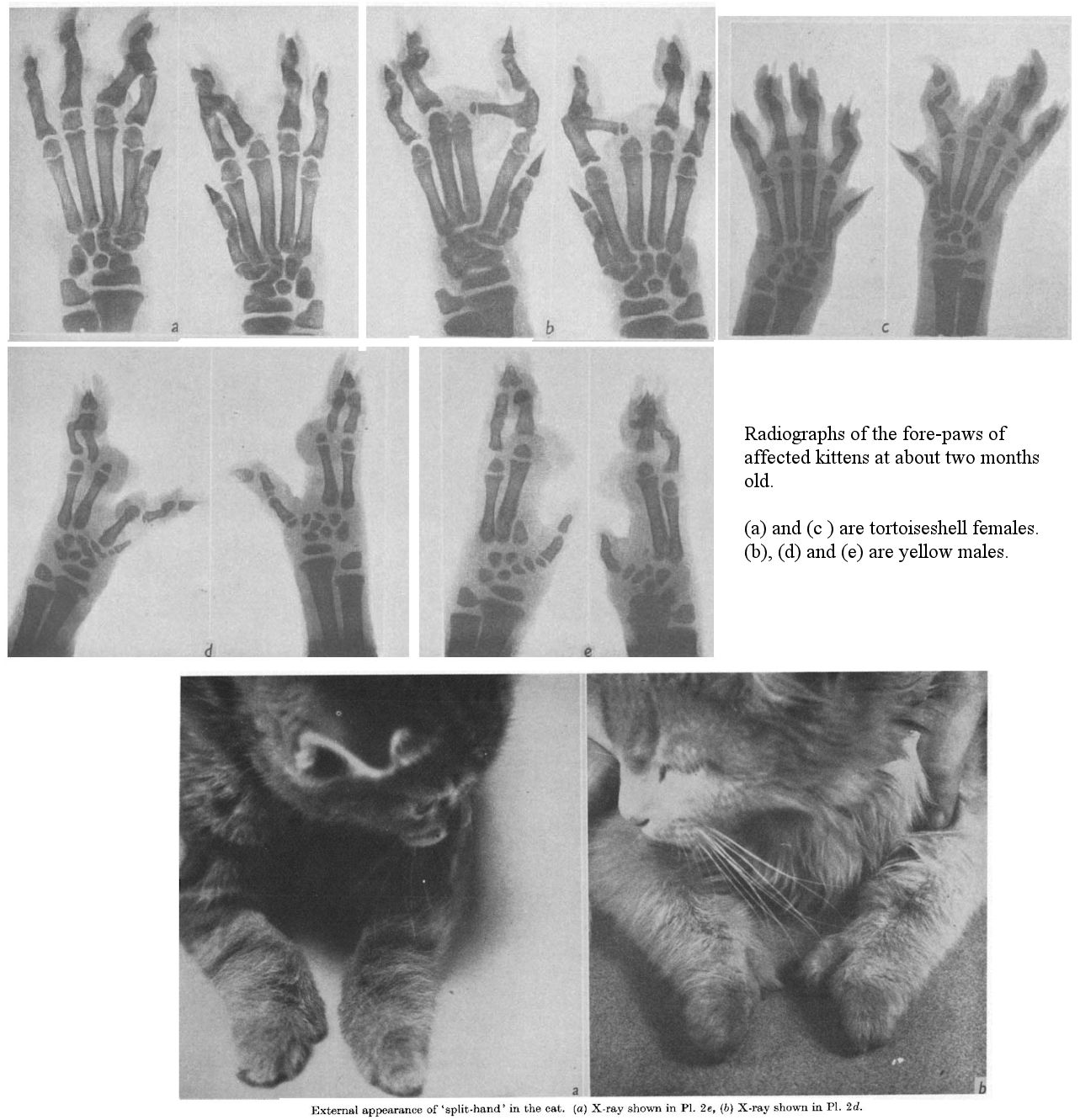
SYNDACTYLY - OTHER FUSED TOES
While the lobster-paw condition may be genetic or congenital, other forms of syndactyly are probably congential (non-inherited). Fused central toes also occur (these seem more likely on the hind paws).
Anastopoulos Thanos of Sparti, Greece provided images and details of a different form of fused toes: "A few months ago I adopted a pair of stray kittens found on the street outside my house. 1female and 1male. They have developed a liking to the indoors. The reason for this email is an anomaly on the hind paws of the female cat ("Zooka", see photos). If I’m right its called syndactyl, a union of the ‘toes’. It does not appear on the front legs of the cat. The number of nails is correct but the cushion is united. The bone structure feels to the touch normal. The affected nails seem to have problem retracting. It does not hinder the cat’s movement other than a "clicking" sound due to the nails hitting the floor tiles. I am not thinking of seeking medical or surgical treatment because the cat shows no distress over it."
|
Fused centre hind toes |
|
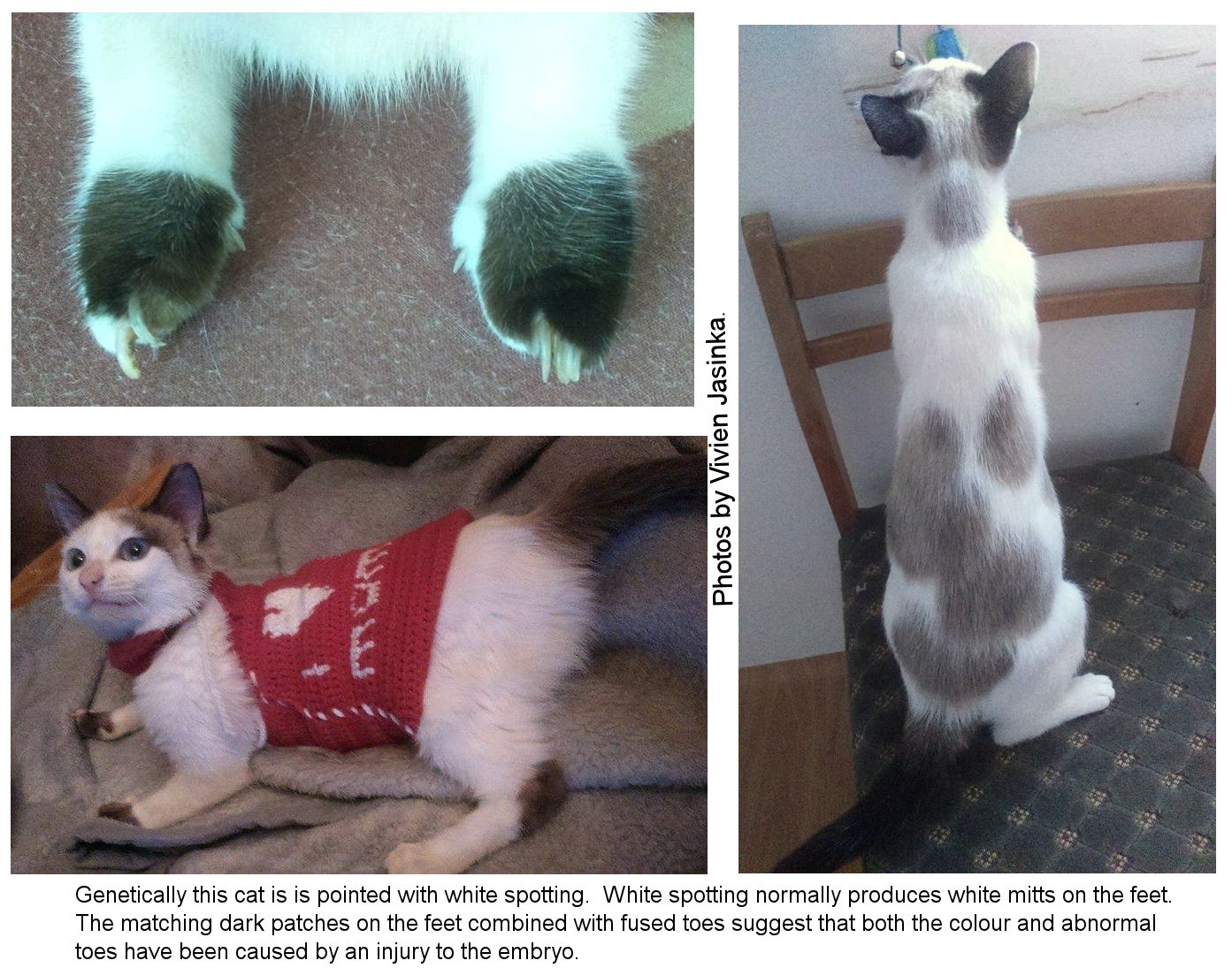
Raimi Cyan Rayfield is another case of fused central digits. There were two feral sister cats whom each had a litter of kittens two days apart. The shleter in Seattle, WA, USA fostered all 12. One of the kittens, Raimi, has a fusion of the center pads and the nails forming a "superclaw" which does not retract. The inner digit (not the dew claw) nail turns outward on the same paw. Only one paw is affected. There appears to be a little pad in between the fused pads as if a third pad was partially formed. (Photos and information from Amy Russell, a cat foster parent for a non-kill shelter in Seattle, WA USA)
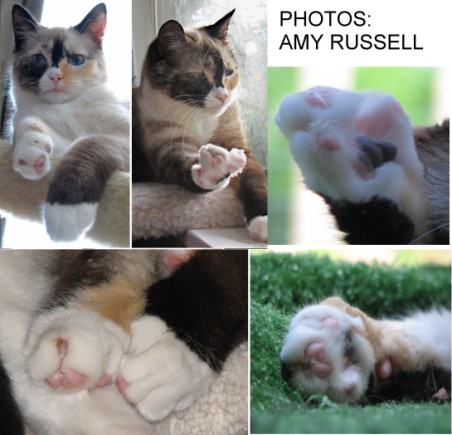
In June 2008, Stine Ødegård came across this instance of fused toes in a Birman kitten where the 2nd and 3rd toe on the left hind foot were fused. No related cats have this defect. Because it occurs on one hind foot and not both hind foot, this is a developmental anomaly and not a genetic defect. Somehow the developing limb bud misinterpreted instructions or may have been damaged rsulting in two toes fused together.
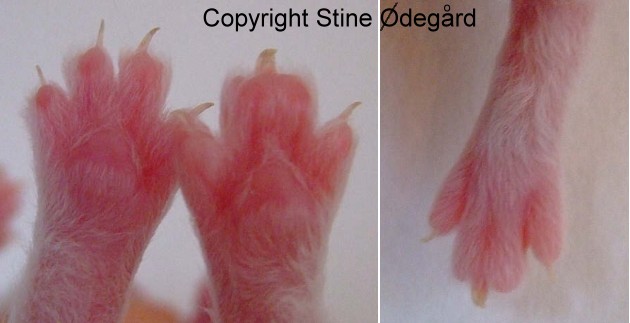
Nikki Raver provided this photo of her syndactyl grey kitten, Eugene. On Monday April 16, 2007 a stray tortie cat that had "adopted" her family gave birth to 3 kittens. The final and smallest kitten to be born had deformed front paws. The other 2 kittens have normal paws. The photo was tekn when Eugene was less than a day old. His right paw is more severely deformed than the left paw. The left paw (harder to see in the photo) has the correct number of toes, but 2 are fused at the bottom, one is misshappen, and the toes point in opposite directions as though they are divided with 2 going one way and 2 the other (lobster foot). Eugene has no problems nursing. As an adult, he will need his claws clipped as they may snag on soft furnishings and will be harder for him to strop on a cratching post.
|
|
|
|
Above is another case of non-symmetrical fused toes.
Virginia Gothard (Charlotte, NC, USA) provided this photo of "Mitty", from a litter born in July 2010. Mitty appears to have the dew claw (thumb) and first digit fused and a cleft between the fused digit and the rest of the toes.
Brachydactyly is not to do with the number of toes, but the length of the toes. Brachydactyly means "short toes". I have only seen one brachydactylous cat in the flesh - a ginger and white male rescue cat whose toe-pads attached directly to the palm of the paw i.e. he lacked the "finger sections". It was necessary to trim the claws regularly and they grew at irregular angles. The lack of jointed toes resulted in minor mobility problems e.g. in running and on landing when jumping, but he was otherwise not inconvenienced by the condition. Also, he could not knead properly. This case was believed to be due to a birth defect (developmental abnormality). In humans, brachydactyly is associated with some forms of dwarfism.
Zack, decribed and shown in the section on syndactyly has brachydactyly as a side-effect. The toes of his front feet lack a joint as a result of the feet not forming normally.
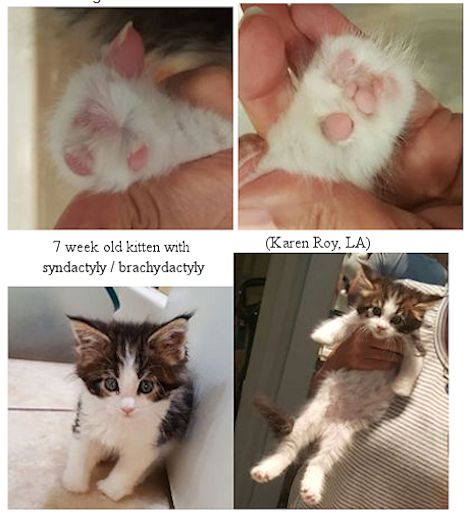
The photos show a 7 week old kitten that presented with short toes, some fusion and also a flat chest. The kitten was active and not hampered by the shortened toes. In these cases, it is sometimes necessary to remove the claws on the affected feet because they grow at abnormal angles.
FUSED CLAWS (SUPERCLAWS)
Vanessa Hickling sent me these photos of her cat Foxy, adopted in 2017, who has a fused “superclaw” that looks as though she has stepped on a snail. She has three toes that appear to have fused nail beds.
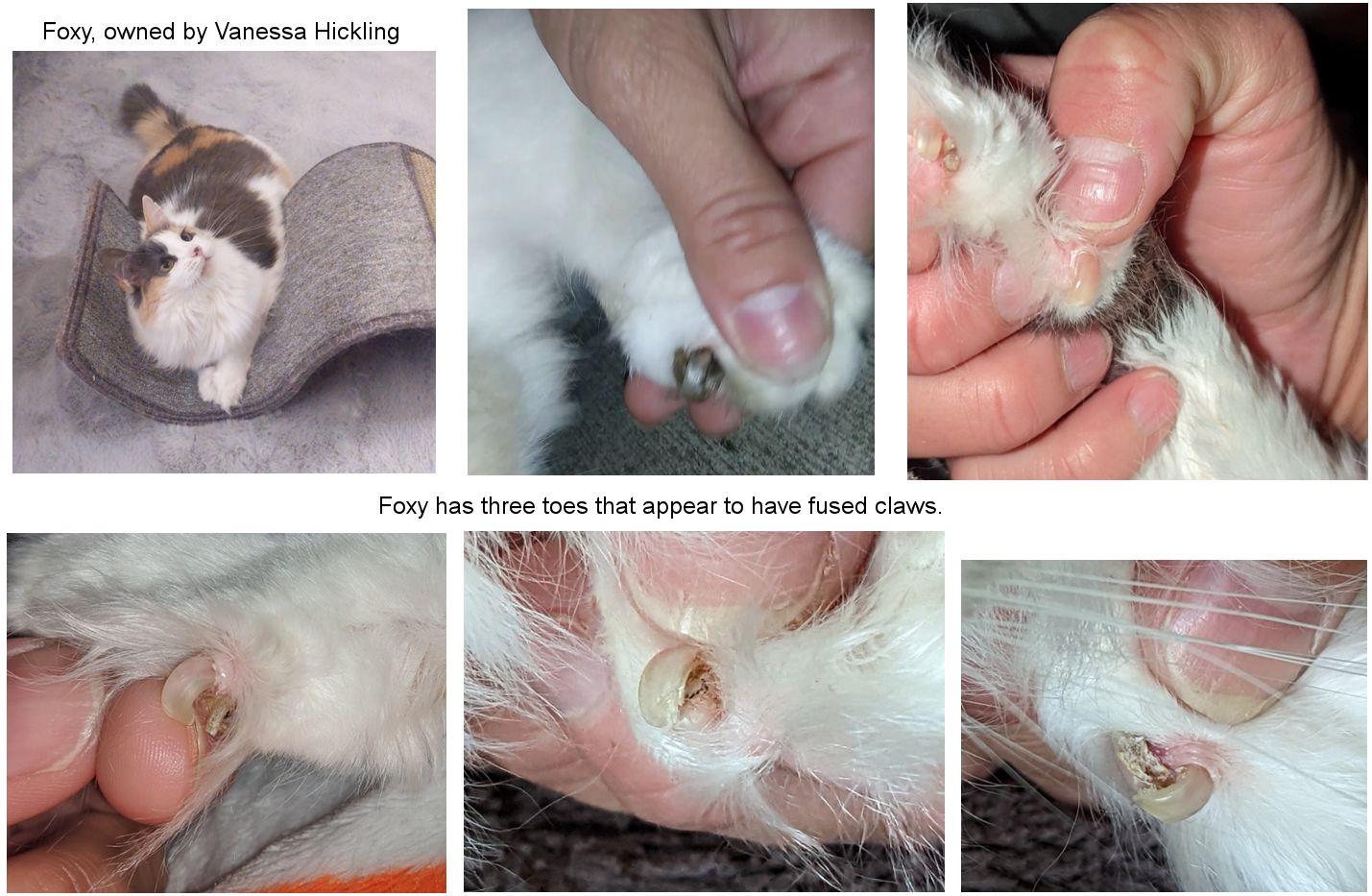
2016. Cat Okita sent some photos of her nearly 5 month old random-bred cat from the Fort Lauderdale, Florida, USA area. He is e’s another 4 + (1) + 1 + (1) in front, and 5 in back — but only has horns on his 7th toe (i.e. mitten foot where extra claws are tucked between the normal foot and "thumb" - the numbers in brackets mean extra claws that aren't on a fully developed toe). He also has "horns" that are clearly dead/built up skin and can be safely clipped. The claw on the horned pad is thick and heavy and is probably two fused claws. Toes 5 and 7 have non-retractile claws and a pad.

OTHER ANOMALIES
Arachnodactyly (spider-digits), a condition causing longer than normal toes, has not been reported in cats to my knowledge. The condition of extra joints/extra bones in one or more of the digits (causing them to be extra-long or extra-flexible) is hyperphalangy.
Uneven Length Toes #1. As well as heritable traits, some individual cats simply have curious toes e.g. uneven length of toes or a twisted toe. These are one-offs caused by early injury or the way the limb has developed in the womb (i.e. not inherited trait). "Bryn" writes "One of our cats has a curious toe on one back foot. It is much smaller than the other four, and is pushed up, so that when the foot is viewed from the bottom, she appears to have three toes. The small toe has a claw. All of her other feet seem to be normal" (photos provided, see below).
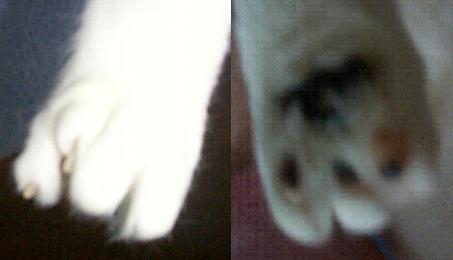
Uneven Length Toes #2. Courtney Kahler (2003) provided the following photos and information about her cat Kolohe whose condition is similar to syndactyly, but probably congenital (birth defect) not hereditary. "I have a cat (Kolohe) who either was born with syndactyly in one front paw or she has a congenital defect very similar. She is essentially missing one toe, has a thumb for a dew claw with a non-retractable claw, and the other 3 toes are semi-fused but do have retractable claws. The smallest toe on the outside of the paw is not as fused as the 2 next to it. The paw pads in 2 places on her paw seem to grow and she tends to chew on one of them, but it never bleeds. So that part of her paw pads looks a bit rough. The other paw pad grows out from her foot almost in the shape of a claw, but it’s tough paw pad and nothing else. You will be able to see that in the picture. She must occasionally chew that off too ‘cause it’s not always that long.
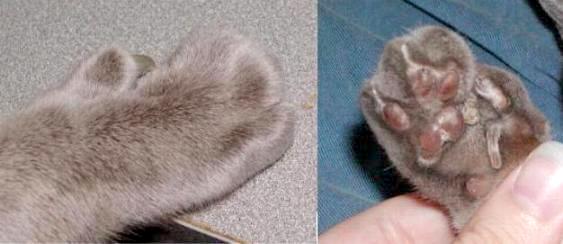
Her breeder believed this was a congenital defect not genetic since she has never seen it before in any other kittens. But both parents are spayed/neutered so if it is genetic it won’t appear again. Kolohe is also spayed. It has no effect on her whatsoever, she is as active as any other Tonkinese and can play and climb with no problem. I do have to keep the one claw clipped because it can snag on the carpet. When she sits up she sits with that paw out to the side. She’s an adorable cat regardless of anything and we often call that foot her lobster claw. "
Another reader reports that her male polydactyl Lynx-point Siamese mix, Tommy, had horny growth similar to those of Kolohe. Tommy's growths grow right up to his claws if left unclipped. In addition, some of his claws are mis-shapen: one is almost flat, and grows square, but twists like a DNA strand while a double dewclaw on the back looks like 2 claws side by side, fused halfway up and barely fits in the claw clippers.
Off-Centre Claws. Bernice adopted a kitten called Ashley in November 2005. She has long toes (she is a very long cat) and some claws are off-centre as shown by the photo of her back foot (below).
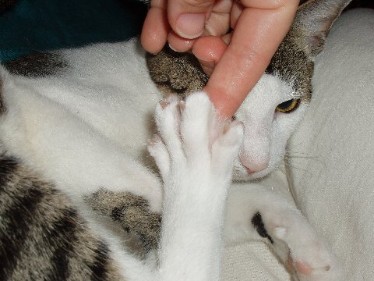
GLOSSARY